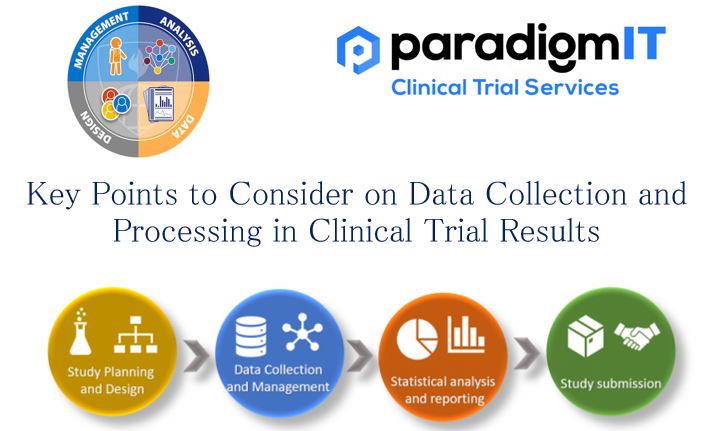Data collection at the site is the process of gathering data from a specific location or setting. This can be done in a variety of ways, such as surveys, interviews, observations, and document analysis. The process typically follows these steps: identify the data needs, design the data collection method, collect the data, analyze the data, and interpret the data. The following are few key points to consider on Data Collection and Processing.
Standard Operating Procedures (SOPs): To preserve consistency and uniformity throughout the trial, SOPs for data collection, management, and analysis must be developed and put into practice. SOPs offer clear guidelines and recommendations for data validation procedures and support the upkeep of uniform procedures among several sites and investigators.
Electronic Data Capture (EDC) Systems: EDC systems eliminate the need for time-consuming transcription by enabling investigators, study coordinators, and other authorized individuals to enter data directly. To help prevent errors during data entry, these systems usually include data validation checks, range checks, and logic checks. Real-time data examination and query management are also possible with EDC systems, which boosts productivity and data quality.
Source Data Verification (SDV): Source Data Verification (SDV) is the process of comparing data from the trial’s database to the source documents, such as medical records, lab findings, and case report forms. SDV assists in discovering discrepancies, errors, or missing data by doing routine on-site or remote visits to verify data accuracy, completeness, and methodology adherence.
Data cleaning and query resolution: Data cleaning entails finding and fixing data anomalies, missing values, outliers, and inconsistencies. Data queries are created to remedy any issues found during data validation. The accuracy and completeness of the data are guaranteed by the prompt processing of queries.
Data Monitoring Committees (DMCs): Also known as Data Safety Monitoring Boards, DMCs are unbiased teams of professionals entrusted with reviewing clinical trial outcomes and ensuring patient safety. DMCs do interim studies to determine the correctness, dependability, and integrity of the data. If there are any difficulties, they can recommend adjustments or the experiment’s termination.
Statistical Analysis: A thorough statistical analysis is required for spotting irregularities, outliers, and patterns that may indicate data quality issues. Numerous statistical tools, such as descriptive statistics, regression analysis, and sensitivity analyses, aid in the detection of potential data biases or inaccuracies, allowing effective quality control and data validation procedures to be implemented.
Documentations: is a crucial aspect of any research, clinical trial, or data management process. Each step of the process should be thoroughly documented to ensure accuracy, transparency, and compliance with regulatory guidelines. Below, will outline the typical documentation associated with various steps in the clinical trial process, leading up to the Database Lock (DBL) stage:
- Annotated CRFs: Annotated CRFs contain data collected during the clinical trial, with additional information and explanations. These are the most important documents in the SDTM process, as they provide a mapping between the data in the CRFs and the SDTM data elements. They are also used to track the metadata definitions for the data and ensure that the data is submitted in a standardized format.
- DMP: The Data Management Plan (DMP) is a document that describes the overall data management process for a clinical study. It includes information on the data sources, data flow, the data collection methods, the data storage and retrieval methods, data cleaning processes, data handling conventions, and data quality control measures and the data analysis methods.
- DVS: The Data Validation Specifications (DVS) document describes the data validation rules that will be used to check the data for accuracy and completeness. These rules are typically based on the SDTM data elements. The DVS should be well-documented with clear explanations of validation checks performed on the data.
- Reconciliations: Reconciliations are used to compare the data from different sources to ensure that it is consistent. This is typically done by comparing the data from the CRFs, the External database, such as lab reports.
- Database Lock (DBL): Database Lock is a critical milestone in a clinical trial when the database is frozen and no further changes are allowed. Documentation at this stage includes:
Data Freeze Memo: A memo stating that data has been frozen and explaining the process leading up to the database lock.
Database Lock Report: A summary of activities leading to the database lock, including the date and time when the lock occurred.
Final Data Listing: Comprehensive data listings showing the collected data after any data cleaning or corrections.
Independent Audits and Inspections: Independent organizations or regulatory agencies may conduct external audits or inspections to add another level of verification. These audits confirm adherence to protocols, legal obligations, and Good Clinical Practice (GCP) standards, fostering trial quality and data integrity.
Clinical trial sponsors, investigators, and regulatory organizations can strengthen the dependability of findings, boost trust in trial results, and ultimately improve patient safety and outcomes by putting these data validation procedures into practice.
For more information –
Visit our website – www.paradigmit.com
Or you can write us at ask@paradigmit.com
Follow us for more – https://www.linkedin.com/company/paradigmittechnologyservices/?viewAsMember=true


